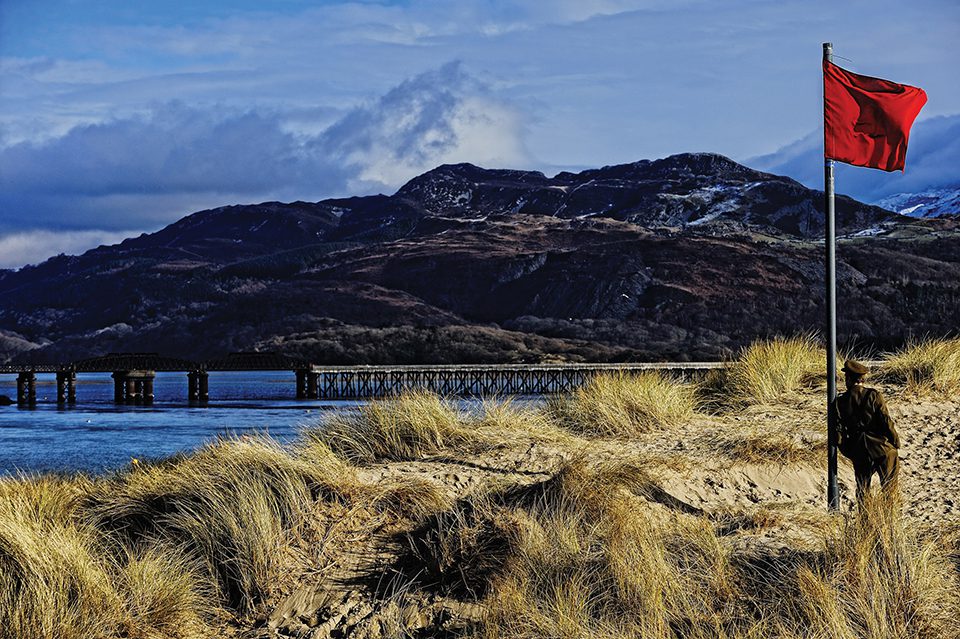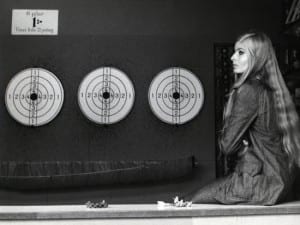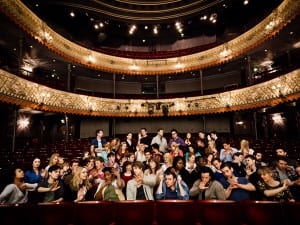Contemporary performer, Marc Rees, transforms a Welsh town into a stage, unveiling and exploring the charms and stories of this seaside community through a creative trajectory.
You are not likely to be familiar with Barmouth. Situated on the west coast of Wales, on the corner of Snowdonia, it’s a popular destination for tourists from Manchester and Birmingham, but its influence beyond these cities is limited. At first glance, it’s surprising that this small town (population 2,230) attracted the attention of acclaimed Welsh performance artist Marc Rees (b. 1966).
Recently commissioned by the newly formed National Theatre Wales (launched November 2009 via live digital broadcast), Rees has created a site-specific project that will introduce the narratives of this Welsh town to a wider audience through an immersive theatrical journey. Known for his extreme interpretations of history, culture and personal experience, Rees’ ambitious new production explores the contradictions implicit in using an impermanent art form to maintain the memories of a town.
The town counts amongst its admirers such seminal figures as Darwin, Wordsworth, Shelley and Ruskin. Rees explains: “It must have something unique to have attracted these distinguished artists” and upon delving deeper he found Barmouth to be full of inspirations, from its prolific maritime history to the six years during World War II when it was occupied by the Ministry of Defence. Rees discovered a comprehensive pictorial archive collated by the community, recognising that “it was a fantastic documentation of the town from the 1800s until the 1980s” and this archive has proved the catalyst for the production that Rees has conceived. Rees’ vision is to “animate the archive”: For Mountain, Sand and Sea derives its inspiration from these photos and draws on the stories of Barmouth, acquainting an audience with the town through a series of interpretations of local history by various creative practitioners.
For Mountain, Sand and Sea is the fourth production in the inaugural season of National Theatre Wales, a company that Rees describes as “a theatre map of Wales.” The National Theatre’s first season spans the country, with productions staged in a number of unique spaces across Wales. The company’s aim is to create stimulating theatre in the English language, rooted in Wales but with an international reach and For Mountain, Sand and Sea embodies that aspiration. The performance is being staged on a grand scale across Barmouth, in its church halls and on its beaches and participating artists will include Guillermo Weickert, Cai Tomos and Benedict Anderson, who is also Rees’ creative collaborator. Weickert and Tomos are Spanish and Welsh respectively and are both dancers, directors and choreographers, whilst Anderson works in architecture, film, dance and theatre.
The artists are crossing boundaries between disciplines, invigorating notions of performance and audience and blurring the distinctions between theatre and art. Marc Rees has worked with some of Britain’s foremost physical theatre companies and he recently won the Wales bid for the Cultural Olympiad project. He is an interdisciplinary artist and states that For Mountain, Sand and Sea is a performance that “really encapsulates it all; it has film, it has sound and all the artists I work with are great dancers.” The artists he has selected are all in some way reflections of his own work: “It’s really important to work with people that I respect and know and who can respond in a particular way to the brief.” This trust is particularly vital in a production this complex, in which the audience will be split into two groups and led on an excursion through Barmouth. They will encounter the various performers in different locations and “witness the history come to life” through the artists’ interactions with the material provided by the archives and the community.
Rees is enthusiastic about involving the community with the project: he created “a temporary story shop in Barmouth, where residents could come and recall their memories, anecdotes and recollections.” These stories are woven into the production, re-imagined by the international artists and incorporated into their performances. Rees describes his role as “an archaeologist exhuming the multi-layered history of Barmouth to reveal these fossils of fact and fiction and then to pass them on to the artist to re-animate and preserve through performance.” This is an unusual concept: performance is by nature transient and the idea that one could hope to preserve something through the medium seems paradoxical. However, Rees is adamant that the production “is not a re-enactment of historical fact, this is a contemporary art experience from my perspective as a creative interpreter.” For Mountain, Sand and Sea is not so much about preserving and presenting the history of Barmouth as much as it is about perpetuating the idea of living theatre, a theatre that is influenced by and adapted from the memories and experiences of a place and its people.
The organic theatrical experience that Rees is striving for has required the involvement of the community and a number of locals will even be participating in the performance, as other real-life historical residents. The primary school has also been tasked with creating an elephant, in memory of one that died there in 1839. Rees describes this as a “lament for the dead elephant” and speaks of an ambition to “resurrect that elephant.” This is a fitting metaphor for the entire project, in which some piece of history, whether truth or rumour, is resurrected and re-imagined from a contemporary perspective.
The community aspect to the production does raise some questions about the validity of an artwork in which everyone can contribute; Benjamin Buchloh famously discredited Joseph Beuy’s notion of assimilation over its failure to recognise the need for distinction in creating meaning. However, in light of Rees’ vision and the theatrical context this criticism against the democratisation of art seems hardly appropriate, since theatre as a medium is necessarily democratic. Whilst art does not need a viewer to be considered art, a performance without an audience is simply a rehearsal; in theatre the audience is always a part of the experience even when they are not actively involved.
The inclusion of a local element actually serves to offer yet another layer to this already multi-layered performance: the concept is that the town becomes the theatre, thus the process of involving the community becomes part of the theatrical endeavour. The residents of Barmouth are its living history, adding another scene to the theatre of the town. Rees points out that it’s impossible to avoid the contemporary experience; when you use a space like a church hall, you can’t escape the associations already equated with that place and likewise, by using the local community he offers another narrative to the performance.
This idea of simultaneous narratives is something integral to Rees’ concept. He describes one of Cai Tomos’ performances where memories of World War II are evoked in a nightclub concurrently with the artist’s reflections on dancing in that nightclub in the 1980s: “That juxtaposition, it seems like a conflict of narrative, but for me as a creative, that’s really exciting and hopefully it will be exciting for the audience.” An immersive experience, the work will respond to the audience’s understanding and interpretations of both Barmouth and the performances.
In the spirit of Marcel Duchamp, the spectators complete the work by contributing their own narrative and discovering a personal relationship with the stories performed – an extension on the traditional theatrical audience. It’s possible the performances will resonate most powerfully with those that live in Barmouth, whose immersion in the project will have deeper connections than most and may result in a more emotive experience. Rees is aware of the challenging nature of the production and it remains to be seen whether an audience of people from further afield will feel an intimacy with Barmouth and be able to attach their own narratives and interpretations to the performances. But whether or not this engagement happens, the production will still lead the audience on an extraordinary excursion through Barmouth, the past and the memories and imaginations of the artists and residents. And if audience members have travelled to reach Barmouth then this will work as an extension to their journeys, further reinforcing Rees’ notion of concurrent multiple narratives.
For Mountain, Sand and Sea took place in Barmouth from 25 June – 10 July 2010. www.nationaltheatrewales.org.
Bryony Byrne




